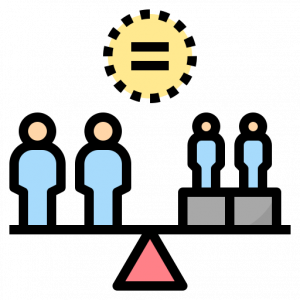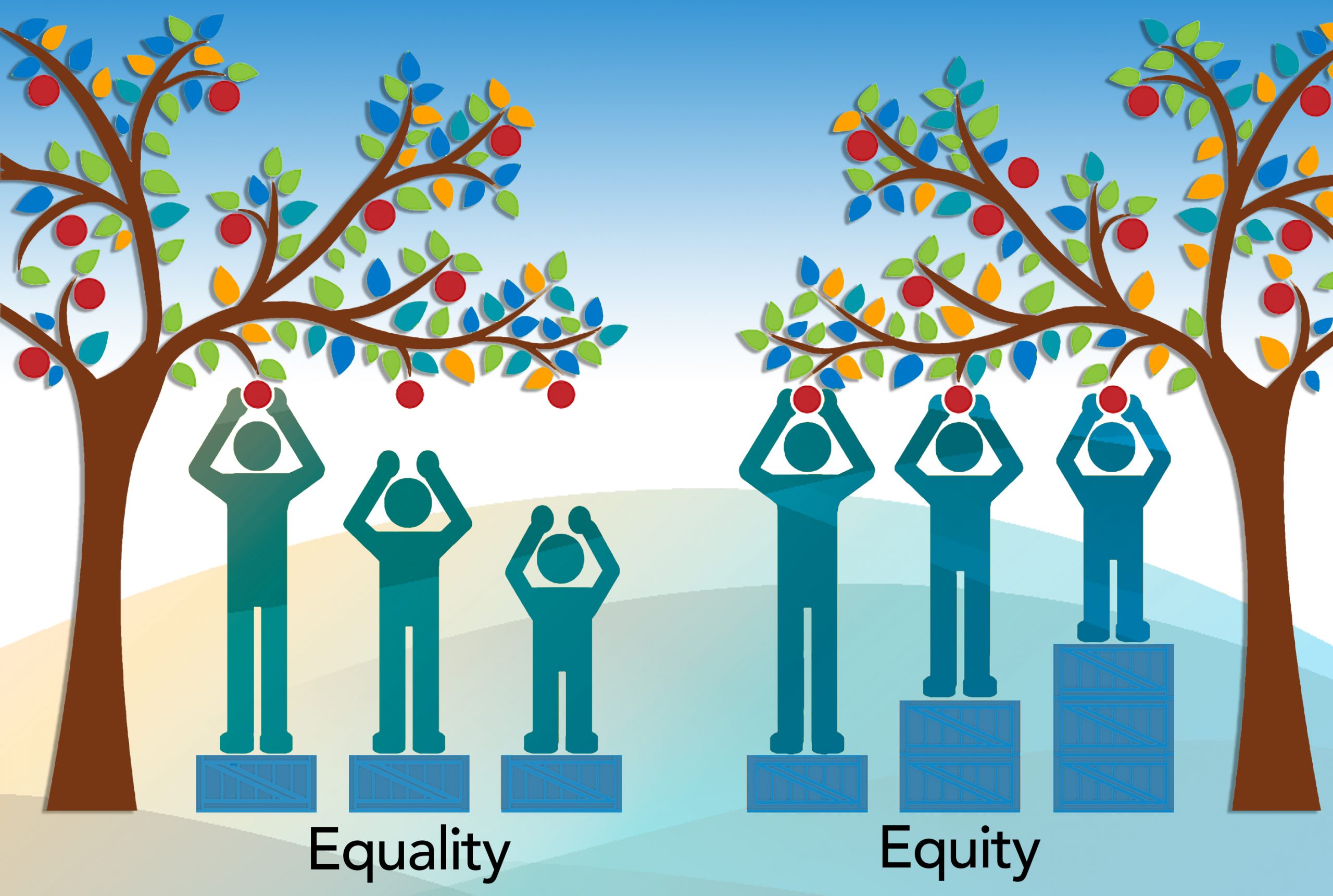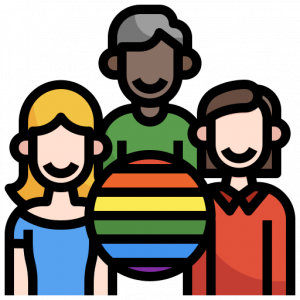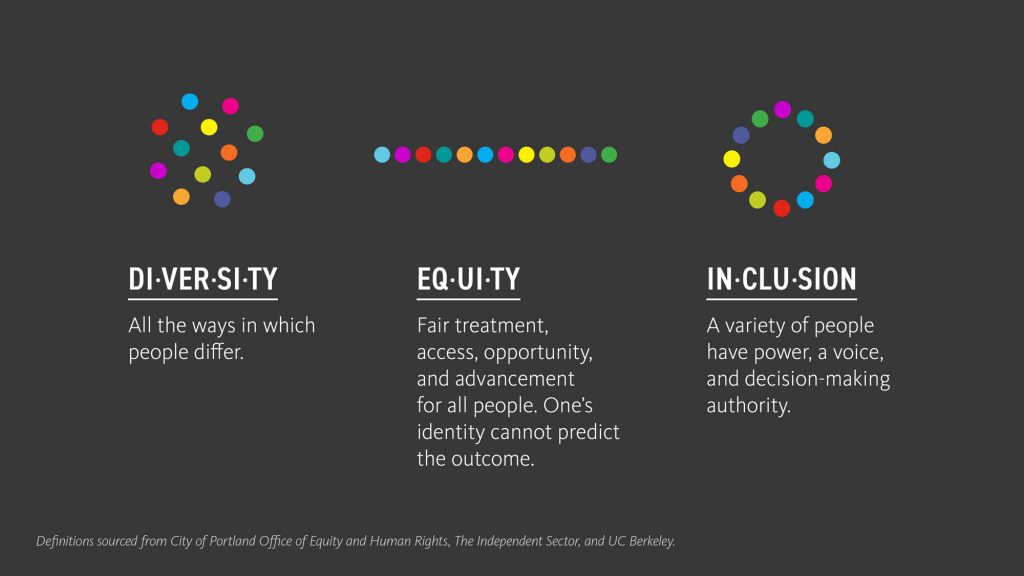4.1: What is EDI?
EDI is an acronym that includes the three interrelated concepts of equity, diversity, and inclusion. When you think of these three words, what comes to mind for you? What do you notice? Do you notice differences, similarities, or relationships between these three words? Let’s first look at some formal definitions with examples and guiding questions for each of these terms.
Equity

We should first start with what equality is and what equity is, as the two concepts are generally confused with one another.
- Equality generally means treating people the same way, to give everyone equal access to opportunities and benefits in society.
- Equity includes treating some people differently, to take into consideration some people’s particular needs and situations (Ontario Human Rights Commission, n.d.)
For example, in the picture below, three people of different heights are trying to reach an apple on a tree. On the left, equality shows everyone is given the same height box to stand on, so only the tallest person could get the apple. On the right, equity shows each person is provided with different numbers of boxes that help all of them get the apple.

Equity is a process that ensures everyone has access to the same opportunities. Equity appreciates that privileges and barriers exist and that, as a result, we all don’t start from the same place. Rather, each of us comes from a different background. Equity is an approach that starts with acknowledging this unequal starting place and makes efforts to address and change this imbalance (Bolger, 2020).
Designing Instruction: In a post-secondary setting, promoting diversity might involve selecting images and examples that reflect various ethnicities, what a family looks like, etc.
Delivering Instruction: Supporting diversity in instructional delivery might entail encouraging input and contributions from a variety of respondents with different attributes and backgrounds.
Diversity

Now, take a minute to think about the diversity of your own team or organization. What do you think? How would your experience change if you were of a different gender, sexual orientation, race, religion, or ability?
Diversity is the presence, in an organization or a community, of a wide range of people with different backgrounds, abilities and attributes including ethnicity, race, colour, religion, age, gender and sexual orientation (Ontario Human Rights Commission, n.d.).
Designing instruction: Selecting images and examples that reflect various ethnicities, what a family looks like, etc.
Delivering instruction: Allowing space for a variety of respondents with different attributes and backgrounds to contribute
Organizations may ask these questions if they are interested in promoting diversity:
- How can our organization ensure our membership reflects the diversity of society?
- How can we encourage diversity through recruitment?
- Why aren’t we appealing to a more diverse group of candidates?
Inclusion

As you work through the content below, think about how you might react if someone asked you, “What is your organization doing to become a more inclusive environment?”
Inclusion refers to taking into account differences among individuals and groups when designing something (e.g., policy, program, curriculum, building, shared space) to avoid creating barriers. Inclusion is about people with different identities feeling or being valued and welcomed within a given setting. As long-time DEI educator, Verna Myers![]() (2018) puts it: “Diversity is being asked to the party. Inclusion is being asked to dance.”
(2018) puts it: “Diversity is being asked to the party. Inclusion is being asked to dance.”
Designing Instruction: In the post-secondary setting, this means, designing assessments while, for example, not assuming that all students prepare for a pop quiz the same way. When using visuals to explain concepts, selecting images and videos that show diversity. For example, avoiding stereotypes (e.g., what does a family look like, what an engineer looks like).
Delivering Instruction: Repeating a student’s question so that everyone can hear it. Providing captions on videos, group work, and lecture presentations.
If one is focused on inclusivity, an organization may ask:
- What is the lived experience for those who are marginalized within the organization?
- Are there barriers in the way of marginalized individuals feeling a sense of acceptance and belonging?
- Are there actions or attitudes, direct or indirect, that we are doing as an organization that is impacting more diverse teams (Bolger, 2020)?
What Equity, Diversity, and Inclusion Really Means

When examining these concepts together, we can say that equity is described as fairness, sameness, and appreciating diversity and inclusion. Diversity is often perceived to be about points of view, representation, and supporting inclusion. Inclusion is about creating environments open to feedback, supporting diversity, and being transparent and flexible.
There are overlaps and contrasts here, and it can be difficult at first to disentangle these definitions:
- Equity is not an outcome. Equity refers to the process a company consistently engages in to ensure that people with marginalized identities have the opportunity to grow, contribute, and develop— regardless of their identity
- Diversity is an outcome: “Wow, this company is really diverse!”
- Inclusion is also an outcome: “We do frequent internal temperature checks, and as far as we know, we have an inclusive and welcoming place for women and people of color here” (Bolger, 2020).
Putting this all together, in the post-secondary setting, EDI means being intentional about EDI right at the beginning of curriculum design, through development and into delivery. The UDL Guidelines![]() introduced in Module 1 support us, as post-secondary educators, to center EDI goals in our teaching and learning environments. UDL offers a clear and concise map to ensure we are reducing barriers for all of our learners, as often as possible.
introduced in Module 1 support us, as post-secondary educators, to center EDI goals in our teaching and learning environments. UDL offers a clear and concise map to ensure we are reducing barriers for all of our learners, as often as possible.
When considering EDI in courses/modules/lessons that you have already created, use the key guiding questions to review your design and your material then make adjustments where necessary.
Activity 1: Reflect on EDI in Your Organization
Think about a process within your organization where you play a key role in either hiring, promoting, or evaluating individuals (students, employees, etc.). Try to specify where that individual decision-making plays a part in this process. Are you able to identify your biases? Have you tried to gather more information to make the process more equitable? How will you use what you’ve learned to create a more inclusive environment?
You are invited to record your reflection in the way that works best for you, which may include writing, drawing, creating an audio or video file, mind map or any other method that will allow you to document your ideas and refine them at the end of this module.
Alternatively, a text-based note-taking space is provided below. Any notes you take here remain entirely confidential and visible only to you. Use this space as you wish to keep track of your thoughts, learning, and activity responses. Download a text copy of your notes before moving on to the next page of the module to ensure you don’t lose any of your work!
References
Bolger, M. (2020, May 24). What’s the difference between diversity, inclusion, and equity? General Assembly. https://generalassemb.ly/blog/diversity-inclusion-equity-differences-in-meaning/
Myers, V. (2018, August 13). Vernā Myers Sizzle Reel Vimeo. https://vimeo.com/vernamyers/vernamyerssizzle
Ontario Human Rights Commission. (n.d.). Appendix B: Glossary. http://www.ohrc.on.ca/en/human-rights-and-policing-creating-and-sustaining-organizational-change/appendix-b-glossary
Portland, G. (2020). Inclusion by design: Insights from design week Portland [Blog post]. Gensler. https://www.gensler.com/blog/inclusion-by-design-insights-from-design-week-portland
Saskatoon Health Region. (2014). Equity vs Equality [Graphic]. https://www.nwhu.on.ca/ourservices/Pages/Equity-vs-Equality.aspx

